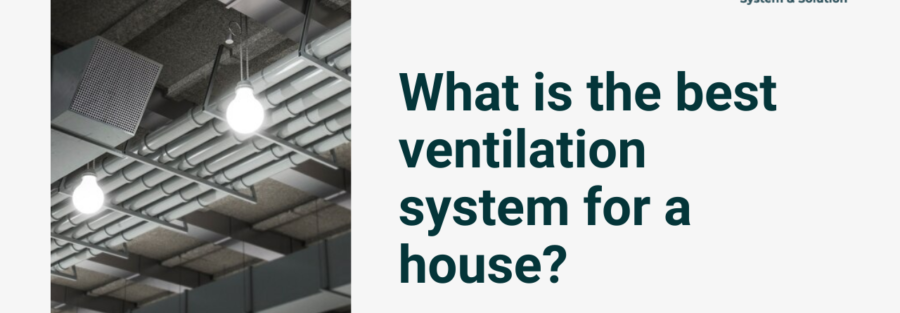Good ventilation is crucial for maintaining a healthy and comfortable living environment. It helps in controlling indoor air quality, removing excess moisture, and ensuring that fresh air circulates throughout the house. With various ventilation systems available, choosing the best one for your home can be challenging.
This comprehensive guide will help you understand the different types of ventilation systems and their benefits to make an informed decision.
1. Importance of Home Ventilation:
Proper ventilation is essential for several reasons:
- Improves Indoor Air Quality: It helps to remove pollutants, allergens, and odors, improving the air you breathe.
- Controls Humidity: Proper ventilation prevents the buildup of moisture, reducing the risk of mold and mildew.
- Regulates Temperature: Ventilation helps in maintaining a comfortable indoor temperature by promoting air circulation.
- Energy Efficiency: Efficient ventilation systems can help reduce energy costs by maintaining balanced air flow and reducing the need for heating or cooling.
2. Types of Ventilation Systems:
There are several types of ventilation systems, each with its own advantages and suitability for different types of homes and climates.
a. Natural Ventilation
Natural ventilation relies on natural forces like wind and temperature differences to circulate air through the house. This can be achieved through:
- Windows and Doors: Simply opening windows and doors to let fresh air in.
- Vents: Installing vents in strategic locations to facilitate airflow.
Pros:
- No energy consumption.
- Simple and inexpensive.
Cons:
- Dependent on weather conditions.
- May not provide adequate ventilation in all areas of the home.
b. Exhaust Ventilation Systems:
Exhaust ventilation systems work by depressurizing the house. They expel indoor air, which is replaced by outdoor air through leaks in the building envelope and intentional vents.
Components:
- Exhaust Fans: Typically installed in bathrooms, kitchens, and attics to expel stale air.
Pros:
- Effective at removing pollutants and moisture.
- Simple to install and maintain.
Cons:
- Can bring in outdoor pollutants.
- May cause drafts and imbalance in air pressure.
c. Supply Ventilation Systems:
Supply ventilation systems pressurize the house by forcing outside air into the building while air leaks out through holes in the building envelope, bathroom, and kitchen vents.
Components:
- Supply Fans: Draw fresh air into the house.
- Air Filters: Clean the incoming air.
Pros:
- Better control over air quality.
- Reduces drafts and cold air infiltration.
Cons:
- Requires regular maintenance of filters.
- Can increase energy costs.
d. Balanced Ventilation Systems:
Balanced ventilation systems introduce and exhaust approximately equal quantities of fresh outside air and polluted inside air. This can be achieved through a combination of supply and exhaust fans.
Components:
- Exhaust Fans: Remove indoor air.
- Supply Fans: Bring in outdoor air.
Pros:
- Effective air quality control.
- Works well in various climates.
Cons:
- More complex and expensive to install.
- Requires regular maintenance.
e. Energy Recovery Ventilation (ERV) Systems:
ERV systems exchange heat and moisture between incoming and outgoing air streams to condition the incoming air. This process helps in maintaining indoor humidity levels and reduces the load on heating and cooling systems.
Components:
- ERV Core: Facilitates the transfer of heat and moisture.
- Fans: Control the airflow.
Pros:
- Improves energy efficiency.
- Maintains indoor humidity balance.
- Enhances air quality.
Cons:
- Higher initial cost.
- Requires regular maintenance.
f. Heat Recovery Ventilation (HRV) Systems:
HRV systems work similarly to ERV systems but only transfer heat, not moisture. They are ideal for colder climates where maintaining indoor humidity is less of a concern.
Components:
- HRV Core: Transfers heat between air streams.
- Fans: Control the airflow.
Pros:
- High energy efficiency.
- Suitable for cold climates.
- Enhances air quality.
Cons:
- Higher initial cost.
- Requires regular maintenance.
3. Factors to Consider When Choosing a Ventilation System:
Selecting the best ventilation system for your home depends on several factors:
a. Climate
- Hot and Humid Climates: ERV systems are ideal as they control humidity and temperature.
- Cold Climates: HRV systems are better suited as they retain heat.
b. Home Size and Layout
- Large Homes: Balanced ventilation or ERV/HRV systems may be necessary for effective ventilation.
- Small Homes: Exhaust or supply ventilation systems can be sufficient.
c. Air Quality Needs
- High Air Quality: ERV or HRV systems provide better control over indoor air quality.
- Moderate Air Quality: Exhaust or supply systems can meet basic needs.
d. Budget
- Limited Budget: Natural, exhaust, or supply ventilation systems are more affordable.
- Higher Budget: ERV or HRV systems, though costlier, offer significant long-term benefits.
e. Energy Efficiency
- Energy Savings: ERV and HRV systems are more energy-efficient, reducing overall heating and cooling costs.
4. Conclusion:
Choosing the best ventilation system for your house depends on various factors including climate, home size, air quality needs, budget, and energy efficiency. Understanding the pros and cons of each system can help you make an informed decision that enhances your living environment.
For those in search of optimal air quality and energy savings, ERV and HRV systems stand out as top choices, offering comprehensive solutions for modern homes.
Investing in a good ventilation system not only improves the comfort and health of your living space but also adds value to your property. Consult with a professional to assess your specific needs and get recommendations tailored to your home. Remember, a well-ventilated home is a healthier and happier home.



